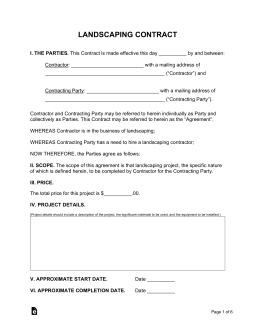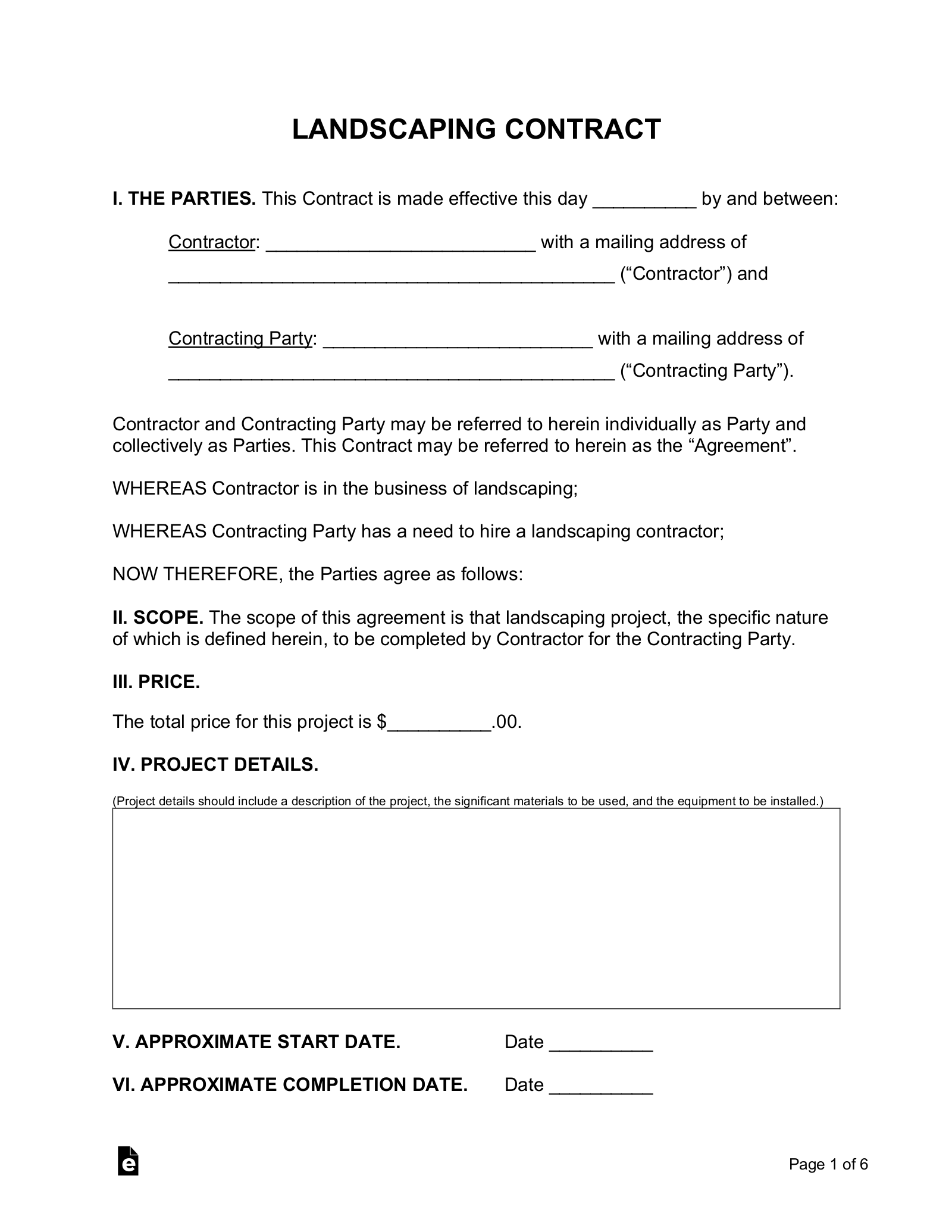Updated July 26, 2023
A landscaping contract is a legal document that formalizes an agreement between a contractor and a client on the terms and conditions of a particular landscaping job. The contract binds both parties to certain responsibilities and outlines the scope, payment schedule, and timeline of the work.
Lawn care contract – used for regular watering, weeding, and trimming of plants within a landscape.
Common Landscaping Services
- Landscape design
- Hardscape installation (e.g. paths, patios, steps)
- Planting/transplanting of trees and plants
- Removal of trees and yard debris
- Installation of irrigation and drainage systems
Table of Contents |
What Should Be Included?
1. Scope of Work
A landscaping contract should outline the scope of the work being contracted so that both the client and the contractor are clear about how much time, labor, and equipment the project will involve. In defining the scope of a job, the contractor should consider the size of the landscape, the accessibility of the property, and whether the job will require follow-up visits or regular maintenance.
2. Location
A contract should include the address of the property for which the landscaping work is being completed. Specificity here precludes the possibility of a customer expecting landscaping services at multiple properties.
3. Payment
A landscaping contract should explicitly outline the contractor’s payment policy. Will a late fee be tacked onto late payments? Should payment be provided upfront? Will payments be required at regular intervals?
It’s common for landscaping contractors to require a percentage of the final cost upfront before beginning the work and require the remainder of the payment plus material costs once the job is complete. A landscaping contract should also specify methods the client can use to pay for the service.
4. Timeline
A contract should include a project’s start and end date. If the contract sets out a schedule for regular maintenance, it should explicitly state the dates on which the service will be performed.
Because landscaping jobs often take place outside, it’s important to acknowledge that weather-related delays may occur and to outline a policy for handling them.
5. Insurance
This section of the contract outlines the extent to which the contractor is covered by insurance. Mention insurance for property damage that results from landscaping activities, as well as worker’s compensation insurance that comes into effect when landscapers are injured on the job.
6. Cancellation Policy
A landscaping contract should state what happens if either party cancels the contract. What kind of notice is required, and how should the notice be given? What are each party’s obligations if the contract is terminated?
Common Landscaping Rates
- Landscaping installation: $3,000 – $16,000
- Sod installation: $1,100 – $3,000
- Turf installation: $3,000 – $10,000
- Sprinkler installation: $1,800 – $5,200
- Tree removal: $200 – $600 per tree
- Landscape design: $50 – $100 per hour
(Source: Home Guide)
Licenses and Permits
While landscapers generally don’t need to be licensed, licensing and certification courses can expand a contractor’s chances of being hired. However, specific landscaping services will require permits from city, county, or state agencies. These include removing trees and spraying for pesticides.
Check with a local building department to understand what needs permitting, then specify in the contract who will be responsible for sourcing and paying for those permits.
Sample Landscaping Contract
Download: PDF, MS Word, OpenDocument
LANDSCAPING CONTRACT
I. THE PARTIES. This Contract is made effective this day [DATE] by and between:
Contractor: [CONTRACTOR NAME] (“Contractor”) and
Contracting Party: [CONTRACTING PARTY NAME] (“Contracting Party”).
NOW THEREFORE, the Parties agree as follows:
II. SCOPE. The scope of this agreement is that landscaping project, the specific nature of which is defined herein, to be completed by Contractor for the Contracting Party.
III. PRICE. The total price for this project is $[DOLLARS].00.
IV. PROJECT DETAILS.
(Project details should include a description of the project, the significant materials to be used, and the equipment to be installed.)
[PROJECT DETAILS]
V. APPROXIMATE START DATE. [DATE]
VI. APPROXIMATE COMPLETION DATE. [DATE]
VII. FINANCE CHARGE. (Select one)
☐ No finance charge applies to this Contract.
☐ A finance charge of $[DOLLARS].00 applies to this Contract.
VIII. DOWN PAYMENT. (Select one)
☐ A down payment is not required under this Contract.
☐ A down payment in the amount of $[DOLLARS].00 is required under this Contract.
IX. DOCUMENTS TO BE INCORPORATED INTO THIS CONTRACT. The following documents shall be attached to and incorporated into this Contract:
[DOCUMENT DETAILS]
X. PAYMENT. Customer shall pay (Select one):
☐ remaining balance shall be paid in full upon completion of work.
☐ on a schedule of progress payments as follows:
[PAYMENT SCHEDULE]
XI. WORKERS COMPENSATION INSURANCE. (Select one)
☐ Contractor has no employees and is exempt from workers’ compensation requirements.
☐ Contractor carries workers’ compensation insurance for all employees.
XII. COMMERCIAL GENERAL LIABILITY INSURANCE. (Select one)
☐ Contractor does not carry commercial general liability insurance.”
☐ Contractor carries commercial general liability insurance.
XIII. WARRANTY. All work shall be executed to industry standards and shall remain free from defects in workmanship for a period of [TIME PERIOD] after Contracting Party’s final payment.
XIV. TERM. The term shall be from time of execution to time of final payment unless otherwise terminated as provided herein.
XV. TERMINATION. This Agreement shall automatically terminate upon Contracting Party’s delivery of final payment to Contractor.
XVI. SUBSTANTIAL COMMENCEMENT OF WORK. A Substantial Commencement of Work shall be defined as the delivery of materials to the jobsite or the actual physical commencement of any of the work to be performed pursuant to this Agreement; either of which may occur first.
XVII. CHANGE ORDERS. Changes to the work that is to be performed under this Contract, including additions or subtractions to or from it, shall be accomplished by the use of a Change Order.
XVIII. PROPERTY LINES. Unless otherwise set forth in the description of work, property lines shall be determined by Contracting Party.
XIX. WEATHER DELAYS. Both Parties hereby acknowledge that reasonable delays may be expected due to inclement weather.
XX. DELAY FOR NON-PAYMENT. If Contracting Party fails to make any payment required hereunder, Contractor shall have the right to halt and delay any remaining work until payment is made.
XXI. TOXIC OR HAZARDOUS MATERIALS. Should Contractor or Contractor’s subcontractors or their employees encounters any toxic or potentially hazardous materials then Contractor shall immediately halt work until such time that Contracting Party causes such condition(s) to be remediated by properly licensed specialists.
XXII. BROOM CLEAN CONDITION. Upon completion of the work described in this Contract, Contractor shall leave the jobsite in broom-swept condition.
XXIII. MARKS FROM HEAVY EQUIPMENT. To complete the work defined herein, Contractor may use heavy equipment. Heavy equipment may leave marks on driveway, pavers, and other areas.
XXIV. NO FAULT DAMAGE. In the event that the jobsite or any of the work, improvements, equipment, appliances, or materials are damaged as a result of fire, vandalism, theft, flood or any other event beyond Contractor’s control then Contractor shall not be required to repair such damage.
XXV. JOBSITE PREPAREDNESS. Prior to estimated start date, Contracting Party shall prepare the jobsite for work to commence by removing any equipment, rubbish, junk, or any other items that may limit Contractor’s ability to commence work.
XXVI. PERMITS. Unless otherwise set forth elsewhere under this Agreement, Contractor shall be responsible for obtaining and paying for the permits required to perform the work described herein.
XXVII. FORCE MAJEURE. If Contractor is unable to perform its obligations hereunder due to events beyond Contractor’s control, then Contractor shall not be in breach of any of the covenants herein but shall be permitted to delay any work for the amount of time required for the event to be remedied.
XXVIII. MATERIALS PRICE INCREASE. If the price of any appliance, machine, or material should increase by more than 5% between execution of this agreement and the time of the item’s purchase or rental, then Contractor shall be entitled to additional compensation commensurate with the actual increase in price.
XXIX. EFFECT OF FINAL PAYMENT. By making the final payment pursuant to this Agreement, Contracting Party acknowledges that all work has been satisfactorily completed to industry standards.
XXX. INTELLECTUAL PROPERTY LICENSE. Contracting Party hereby grants Contractor a non-exclusive, non-transferable license to use, copy, and distribute images of the work, either in-progress or completed, that is covered by this Agreement, for Contractor’s own marketing purposes.
XXXI. LIEN RELEASES. Upon satisfactory payment being made for any portion of the work performed, the contractor, prior to any further payment being made, shall furnish to the person contracting for the home improvement or swimming pool work a full and unconditional release from any potential lien, claimant claim, or mechanics lien for that portion of the work for which payment has been made.
XXXII. JOINT CONTROL. Unless otherwise set forth hereunder, this Agreement does not provide for Contractor furnished joint control.
XXXIII. GOVERNING LAW AND JURISDICTION. This Agreement shall be governed by and construed in accordance with the laws of the State of [STATE] without giving effect to principles of conflict of law.
IN WITNESS WHEREOF, the Parties have caused this Agreement to be executed as of the day and year first written above.
______________________________
Contractor Signature
[NAME AND DATE]
Printed Name and Date
______________________________
Contracting Party Signature
[NAME AND DATE]
Printed Name and Date


